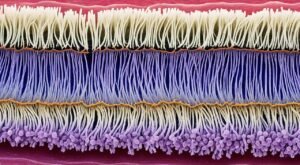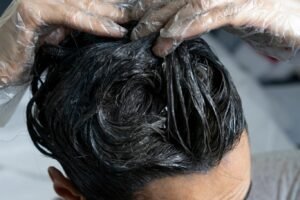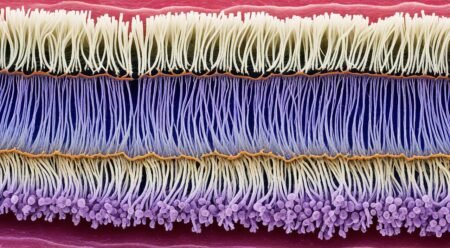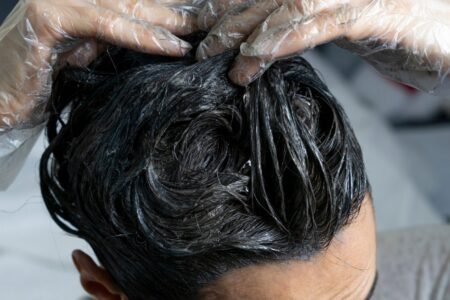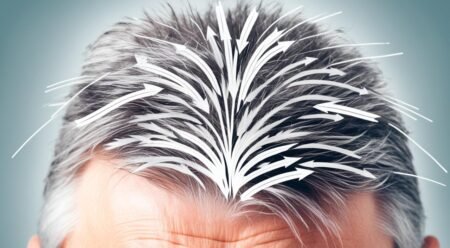The quest for restoration, whether it be of art or self-image, has a profound way of touching lives. Similarly, the journey of hair restoration before and after is one that not only transforms appearances but also revitalizes spirits. Hair loss can be a silent thief of confidence, slowly eroding one’s sense of self. But hair transplant success stories serve as beacons of hope, evidencing that recaptured youthfulness and confidence is not beyond reach.
Imagine catching a glimpse of yourself in the mirror, reflecting a persona that feels more authentic, more vibrant – that’s the power of hair transplant before and after transformations. Each set of hair transplant photos narrates a unique tale of personal triumph, celebrating the blend of science and aesthetics that brings these remarkable changes to life.
As you consider stepping onto the path of hair restoration, let us guide you through the artful journey of reclaiming your natural charm. Permit these visual testaments to the wonders of modern hair restoration to inform your decisions and inspire your aspirations. The stories etched into every before and after are not just about hair—they’re about the renewing of joy and the resurgence of an individual’s narrative etching prominently in their life’s grand canvas.
Understanding the Hair Transplant Process
If you’re considering a hair restoration procedure, demystifying the hair transplant process is crucial to setting realistic expectations for your journey. From the initial consultation to the unfolding of final results, hair transplantation is a multifaceted medical procedure that demands a thorough understanding. Below, we unfold the sequence of steps involved in this transformative journey, aiming to provide you with a comprehensive grasp of what to anticipate.
It all starts with a detailed consultation where a skilled specialist evaluates your hair loss and discusses the potential for hair restoration. This initial meeting sets the stage for a personalized approach tailored explicitly to your needs. Here’s an outline of the procedure:
- Consultation: Sharing your hair loss history and discussing goals.
- Planning: Crafting a unique restoration plan, including selecting the donor site.
- Preparation: Making preparations for the surgery, following the surgeon’s pre-op instructions.
- Surgery: Undergoing the procedure itself, which can vary in duration based on the technique and extent of the transplant.
- Recovery: Post-op care and watching for the signs of successful grafting. It is typical to see some initial hair shedding before new growth begins.
- Follow-up: Regularly scheduled appointments to monitor progress and ensure proper healing.
- Results: Observing final results, usually visible 12 to 18 months post-surgery.
Two primary techniques for hair transplantation are frequently utilized: Follicular Unit Transplantation (FUT) and Follicular Unit Extraction (FUE). Both methods involve transplanting hair from a donor area to an area experiencing hair loss but differ in their approach to harvesting follicles.
FUT, also known as ‘strip surgery,’ involves removing a strip of hair-bearing skin from the back of the head and dissecting it into individual grafts. On the other hand, FUE involves the extraction of individual hair follicles directly from the scalp without the need for excising a strip of skin, thereby reducing scarring.
Understanding these methods is paramount when considering a hair restoration procedure, as each comes with its set of advantages and considerations. Your surgeon will guide you in choosing the technique that best aligns with your expectations and goals.
Equipped with this knowledge, you’re now better prepared to navigate through the decision-making process, ensuring that when you opt for a hair transplant process, you’re doing so with a clear vision of the journey ahead.
The Importance of Choosing a Qualified Surgeon for Hair Transplantation
When considering a hair transplant, the skill and expertise of your surgeon are paramount. It is not just about the procedure; it’s about ensuring that you place your trust in a qualified surgeon who can provide the best aesthetic and lasting outcomes. In this section, you’ll find out why board certification and a proven track record, demonstrated by a robust hair transplant before and after gallery, are critical in selecting the right hair transplant clinic for you.
Board Certification and Training
Board certification is more than a credential; it’s a signal to patients that the surgeon has undergone rigorous training and has been evaluated by their peers in the field of hair restoration. A board-certified surgeon is committed to delivering high standards of patient care and has a deep understanding of both the art and science behind successful hair transplantation.
Reviewing Surgeon’s Hair Transplant Before and After Gallery
Visual evidence of a surgeon’s skill is indispensable. A hair transplant before and after gallery allows you to assess the quality and consistency of the surgeon’s work. Look for a diverse range of cases that demonstrate expertise in treating patients with similar hair loss patterns and goals as yours.
Considerations for Selecting the Right Hair Transplant Clinic
Choosing the right clinic goes beyond the surgeon. You should also consider the level of personalized care, the technology and methodologies used, and the support staff’s expertise. Here’s a comparison to help you differentiate between what various clinics offer:
| Clinic Feature | Why It’s Important | What to Look For |
|---|---|---|
| Surgeon’s Expertise | Directly impacts the success of your transplant | Board certification, specialized hair transplant training |
| Technology | Modern technology can improve results | Use of the latest hair transplant techniques and equipment |
| Patient Care | Ensures a comfortable and safe experience | Attentive staff, comprehensive pre- and post-surgical care |
| Clinic Environment | A reflection of the clinic’s professional standards | Clean, well-organized, and welcoming facilities |
| Before and After Gallery | Shows actual results of previous patients | Diverse array of successful hair transplant results |
Your hair transplant journey is unique, and finding a clinic that aligns with your needs is critical to a successful outcome. Remember, it’s not just about getting the procedure done; it’s about the lifelong impact on your appearance and confidence.
Hair Transplant Before and After: Visual Proof of Success
When considering a hair transplant, seeing is believing. It’s the hair transplant before and after visuals that offer the most convincing evidence of the procedure’s impact. To help you understand the potential for hair transplant transformation, we’ve compiled a series of comparison photos that clearly illustrate the enhancements achieved through skilled hair restoration.

The contrast in these images not only highlights the technical proficiency required for successful outcomes but also serves as a testament to the patient’s journey from thinning or balding to fuller, natural-looking hair. Let’s delve into a comparison that illuminates the transformative power of hair transplantation.
| Before Hair Transplant | After Hair Transplant |
|---|---|
| Visible scalp due to thinning hair | Lush, dense hair with no visible scalp |
| Receding hairline | Restored hairline with natural hair growth pattern |
| Diffuse balding spots | Even distribution of hair over the entire scalp |
| Lack of confidence in appearance | Renewed self-esteem and confidence post-procedure |
It’s clear from these before and after snapshots that hair transplant procedures can yield distinct and life-altering results. However, maintain realistic expectations, as individual results vary based on factors like the extent of hair loss and the hair transplantation technique used.
As you reflect on these transformations, remember that a successful hair transplant comparison goes beyond the surface. It’s about the restoration of both hair and confidence. If you’re considering a hair transplant, approach the process with both hope and a clear understanding that your personal journey will be unique to you.
Real Hair Transplant Success Stories
Delving into the world of hair restoration journey narratives, you’ll discover the transformative effect hair transplants have had on individuals’ lives. These stories not only showcase physical changes but emphasize the renewal of confidence and emotional well-being. As real individuals recount their experiences through various mediums, their journeys provide invaluable perspectives for anyone considering a hair transplant.
Video Testimonials from Patients
There’s something incredibly impactful about watching a person’s demeanor shift as they share their hair transplant testimonial. These video testimonials give a face and voice to the successes of hair restoration. They allow for an authentic glimpse into the elation and gratitude felt by patients who’ve seen significant improvements in their appearance.
Written Accounts of Hair Restoration Journeys
In the written word, patients meticulously document their hair transplant success stories, often detailing every step of their transformation. These narratives offer insight into the patience and commitment required through the process, as well as the triumphant moment of unveiling the full results. Below is a comparative table of individual experiences, pre and post-transplant:
| Before Hair Transplant | After Hair Transplant | Overall Experience |
|---|---|---|
| Frustration with progressing baldness | full, healthy-looking hair | Life-changing, confidence-boosting |
| Difficulty with styling hair | More styling options, restored hairline | Increased self-esteem and satisfaction |
| Concealing hair loss with hats | No longer hides hair, entire profile improved | Profound sense of freedom and happiness |
The Psychological Impact of Hair Transplant Results
The psychological impact resulting from a successful hair transplant goes beyond superficial looks. It’s about the restoration of a sense of identity and the alleviation of deep-seated insecurities. Sharing in the journeys of others, you’ll appreciate how these success stories reflect more than just physical change—they symbolize the reclaiming of joy and a fresh start in life.
What to Expect Immediately After a Hair Transplant
Embarking on your journey through post hair transplant recovery, it’s essential to become acquainted with the nuances of hair transplant aftercare. The period following your surgery is critical for the success of your hair grafts and will require you to adhere to specific care instructions to ensure optimal healing and hair growth.
Immediately after the procedure, it’s normal to experience some discomfort, swelling, and redness. Your scalp may be tender, and you might require pain relief medications as prescribed by your surgeon. Below is a table that provides an easy reference for the post-operative care you should expect and perform:
| Timeframe | Post-Transplant Action | Expectations |
|---|---|---|
| Day 1-3 | Gently wash your scalp with a mild shampoo as instructed by your surgeon. | Some swelling and redness; it’s important to sleep with your head elevated. |
| Day 4-7 | Continue washing with a soft touch and begin to apply any topical medications if provided. | Scabs may begin to form around hair grafts, do not pick at them. |
| Weeks 1-2 | Attend follow-up appointments to ensure proper healing. | Most of the swelling should subside, and scabs should start to fall off naturally. |
| Weeks 3-4 | Maintain a gentle hair care routine; avoid any strenuous activities. | Some hairs may shed, which is a normal part of the hair growth cycle. |
Above all patience is your best ally during this stage. Encountering shedding or the “shock loss” phase is common and temporary, as the transplanted follicles enter a new growth phase. Remember, maintaining diligence in your hair transplant aftercare will foster the desired results and contribute to the longevity of your hair restoration success.
Note: Always follow the advice and guidelines provided by your hair transplant specialist for personalized care instructions tailored to your unique situation.
By understanding what to expect and how to take proactive steps in your care routine, you can help ensure that your post hair transplant healing process is as smooth and effective as possible.
Long-term Hair Transplant Results and Maintenance
After undergoing a hair transplant, you might be wondering about the next steps to ensure the longevity and vitality of your newly restored hair. It’s not only about the immediate aftercare; long-term results and the maintenance of your transplant are pivotal for enduring satisfaction. Let’s delve into the factors that contribute to hair transplant longevity, and discover how your lifestyle and dedicated post-transplant hair care can play crucial roles in sustaining your results.
Common Factors Influencing Hair Transplant Longevity
The permanence of your hair transplant can be affected by various factors. Genetics, the skill of the surgeon, and the type of procedure play a significant role. Even though transplanted hair is generally resistant to the hormonal conditions that caused your initial hair loss, other areas of your scalp may continue to thin over time. It’s important to understand that continued hair loss can influence the overall appearance of your hair transplant over the years.
The Role of Lifestyle in Maintaining Hair Transplant Results
Your daily habits and health choices can either contribute to maximizing the lifespan of your hair transplant or put it at risk. For instance, smoking can impair blood flow to your scalp, while a balanced diet rich in vitamins and minerals supports the health of your hair. Regular exercise increases blood circulation, which can contribute to the maintenance of your hair. Protecting your scalp from excessive sun exposure is also advisable to preserve the quality of your transplanted hair follicles.
Post-Transplant Hair Care Tips
To maintain the density and appearance of your transplanted hair, adopting a suitable hair care regimen is essential. Gentle shampooing, avoiding harsh chemical treatments, and reducing the use of heat styling tools can all help protect your follicles. In addition, regular check-ups with your hair transplant clinic can ensure any concerns are addressed promptly, and further treatments, if necessary, are planned effectively.
Remember, the key to hair transplant maintenance is a combination of professional guidance and your day-to-day practices. With a little bit of effort and care, you can enjoy lasting results from your hair restoration journey.

Comparing FUE and FUT Hair Transplant Before and After Results
When it comes to enhancing your look with hair transplant techniques, understanding the difference between FUE hair transplant and FUT hair transplant is crucial. Each method offers unique advantages and has differing impacts on transplantation aesthetics. Let’s sift through the intricacies of these popular procedures to help you foresee your transformation journey.
Follicular Unit Extraction (FUE) vs. Follicular Unit Transplantation (FUT)
The battle between FUE and FUT is a tale of two techniques. FUE, a more modern approach, involves extracting individual hair follicles from the scalp without leaving a linear scar. On the flip side, FUT involves removing a strip of tissue from the scalp, after which follicles are separated and implanted. This older method often results in a noticeable scar.
Patient Case Studies: FUE vs. FUT Outcomes
Diving into patient case studies reveals the transformative power of both procedures. Before and after photos of FUE hair transplant cases often showcase excellent regrowth with minimal scarring, while FUT before and after scenarios reveal a distinct line where the strip was removed but offer a greater density in a single session.
Scarring and Aesthetics: What to Expect with Each Technique
When it comes to scarring and aesthetics, your choice between FUE and FUT will significantly impact the final look. FUE’s prowess lies in its ability to leave virtually no trace, while FUT, although it may entail more noticeable scarring, can produce a fuller appearance more quickly.
| Technique | Scarring | Recovery Time | Aesthetic Outcome |
|---|---|---|---|
| FUE Hair Transplant | Minimal, punctate scars | Shorter | Less invasive, no linear scar |
| FUT Hair Transplant | Linear scar on donor site | Longer due to sutures | Denser hair in fewer sessions |
Whether you lean towards the pioneering FUE hair transplant to steer clear of linear scarring, or opt for the FUT hair transplant for its denser outcomes, your decision should align with your hair restoration goals and lifestyle. As you weigh your options, remember that your journey to luscious locks is a blend of science and aesthetics, forever transforming not just your hairline, but also your self-confidence.
Managing Expectations: Hair Transplant Transformation Timelines
Embarking on a hair transplant journey brings with it a wellspring of anticipation. However, it’s critical to align your hair transplant expectations with the actual hair transplant timeline and hair regrowth timeline. Each stage marks a significant step in the transformation process, and understanding this evolution will help manage your expectations and prepare for the natural progression of post-transplant hair growth.
Initially, patients may experience shock loss, where some pre-existing hair falls out due to the trauma of surgery. This phase is temporary and usually resolves within a few months. Here’s what you should anticipate in the months following your hair transplant:
- 1-3 Months: Patience is key, as you might notice little to no growth. This is a normal part of the healing process as the transplanted follicles enter a resting phase.
- 3-4 Months: You’ll begin to see new hair strands sprout as the follicles wake up from the dormant phase and start to grow.
- 5-8 Months: This is when the magic happens – your hair will become noticeably thicker and fuller as more follicles contribute to new growth.
- 9-12 Months: Most of the final hair growth has occurred by now, with hair texture and density continuing to improve.
- 12+ Months: Your transformed mane reaches its peak, revealing the ultimate outcomes of the transplant. Some patients might see continued improvements up to 18 months post-procedure.
It’s vital to remember that individual results may vary based on factors such as age, the health of donor hairs, lifestyle, and adherence to post-operative care instructions. As you monitor your hair’s progress, maintain close communication with your hair restoration specialist for personalized care and advice tailored to your unique hair regrowth timeline.
The Role of Genetics in Hair Transplant Results
When you consider a hair transplant, it’s vital to understand the connection between genetic factors in hair loss and the outcomes of such procedures. Your genes have a substantial influence on the pattern and progression of hair thinning and loss, which, in turn, can dictate the success of a hair restoration intervention. By appreciating the role genetics play, you can approach your hair transplant with a well-informed perspective.
How Genetic Factors Affect Hair Loss and Regrowth
The hereditary attributes you carry may predispose you to certain types of hair loss, such as androgenic alopecia, commonly known as male or female pattern baldness. This genetic trait can also impact the regrowth potential of your hair following a transplant. Evaluating these genetic factors is a crucial step in customizing your hair transplant plan. A specialized surgeon can assess your hair characteristics, such as density, color, and texture, which are all influenced by your genetic makeup, to maximize the procedure’s effectiveness.
Personalizing Hair Transplant Techniques Based on Genetic Predispositions
Optimal results are often achieved through a personalized hair transplant strategy that considers your unique genetic profile. Tailoring the technique allows your surgeon to work with the hair you have and strategically place grafts for a natural and dense appearance. This individualized approach helps in compensating for genetic predispositions, such as future hair loss patterns that might impact the long-term appearance of the transplant.
Setting Realistic Goals for Hair Restoration
Your journey towards hair restoration should always involve setting realistic goals based on both your genetic background and the artistic skill of the hair transplant surgeon. Recognizing that genes play a part in the achievable results can help temper expectations and ensure satisfaction with the procedure. With a clear understanding of what can be accomplished, you can look forward to a more confident and fulfilling outcome.
